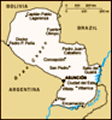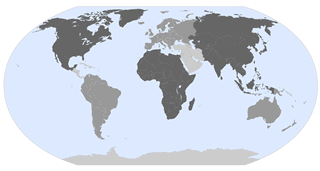Advertisement
Published: September 2nd 2019
After visiting the amazing Iguazú Falls in Argentina together with Gideon, his wife and 3 of their friends, they all decided to visit Iguazú Falls on the Brazilian side too. I decided in advance that I did not wanted to follow the heard anymore (lol), besides I thought it would be the same falls anyway and I decided to go my own way for a week. I took a bus to the border and crossed into Brazil. The bus just drove a little bit through Brazil and then it stopped at the border and I walked into Paraguay...."¡tenés que sentirlo! (you have to feel it). That is the tourism slogan of the country! Why Paraguay? Because it's the country most people tend to skip when visiting South America thus it's not a touristy country. That is exactly why I wanted to go because I was very curious, and I don't regret my choice.
I left the bus and walked towards migration, where everything went quick and smooth. The city where I was is called
Ciudad del Este. The city has about 300.000 inhabitants and is the second largest in Paraguay. If you translate Ciudad del Este into English, it would
be City of the East since it does lie in the east of the country. I didn't find it a pretty city from what I saw. Ciudad del Este is an important trading city where many Brazilians and Argentineans go to do cheap shopping. Therefore the city is often busy and a bit chaotic. For the average tourist it is not an interesting city at all, but the surroundings might be!
I visited the famous Itaipú Dam, built in the Paraná River on the border between Paraguay and Brazil. It was opened in 1984 and is currently the highest producing hydroelectric dam in the world. I took a bus towards the dam, where the entry is free. They have tours going around the facility in comfortable, air-conditioned buses and it was a very interesting and informative tour! The Itaipú Dam provides power for most of Paraguay (if not all) and much of the electricity is exported to neighbouring countries. In the evening I went again to the dam where it is beautifully lit and they give a light-show. From Ciudad del Este I also visited the waterfalls "Saltos del Monday" because I love waterfalls! First I took a taxi
which arrived nearby, but the access to the falls seemed closed and we turned back to the hostel. A little later I eventually found out that the taxi-driver didn't know where the actual entrance is located, believe it or not! Together with a Brazilian guest from the hostel I took another taxi to the right place this time. At the falls you can go down in a see-through elevator and get very close to the falls. Highly recommended! There is also a nice cafe/restaurant where you can eat and/or drink something.
I left Ciudad del Este and headed towards the south of Paraguay and arrived in
Encarnación. The city of about 140.000 inhabitants lies along the Paraná River, right across from the city of Posadas, Argentina. Paraguay is one of the two land-locked countries of South America which means they have no coast. Along the shores of the Paraná River they put sand and created a beach called Playa San José. Coming from Curaçao you'd understand that I was not under the impression but I can understand that for the Paraguayans it is a great place. Parallel to the beach there is also a nice
boardwalk called "Costanera de Encarnación", beautifully maintained and it has couple of bars / restaurants. A lot of people wander around the area and I really liked the atmosphere there. It's a nice place to stroll and hang around. Here I spoke a bit with a few youngsters who were curious to know where I'm from. At the end of the boardwalk there are two old structures, one building and one silo (Molino San José and Silo San José). Both were part of a thriving grain industry in the past.
Encarnación is known because of its carnival celebration and there is a small "Sambódromo" where the annual event takes place for the most part. A beautiful place was the Escalinatas de San Pedro, beautifully covered with colourful tiles honouring women of the fisherman who used to cross the river with goods back and forth.
Just outside Encarnación you cannot miss the ruins of the "Misiones Jesuíticas de la Santísima Trinidad de Paraná". It is one of the best known attractions in Paraguay. This UNESCO World Heritage Site was built by Jesuits in the early 17th century. These so-called Jesuit missions were colonies used to gather and protect the local, native
population to prevent them from becoming victims of the Spanish colonists and their greed. About a half century later, following an expulsion of Jesuits out of the Spanish territories at the time, all these missions were abandoned and eventually turned into ruins. The site is very interesting if you visit with a guide of course.
Just like in Argentina, "Mate" is very popular in Paraguay too (also Uruguay). It's a type of tea drunk out of a cup with a steel straw, therefore you see people everywhere with a cup and a thermos under their arm. In Paraguay people also drink it cold, and it is called "Tereré". Both Mate and Tereré belong to the culture and the Paraguayan way of life, therefore I really wanted to experience and learn more about it. In Bella Vista, not too far outside Encarnación, I visited a Mate factory and plantation belonging to the Selectra Group together with others from the hostel. We received a detailed tour through the facility and received explanation about the production process and the mate plant. Very, very interesting! It wasn't easy to get there. We took a taxi from the main road but on the way back
we hitchhiked, which is a common thing in the area according to our guide at the factory. We got a ride by a friendly gentleman who lives in the area, an area where many have German ancestors.
My last stop was the capital and largest city of Paraguay:
Asunción. The city has about 550.000 inhabitants and lies on the shores of the Paraguay River. Near the shores you'll find the presidential palace, called "Palacio de López" or "Palacio del Gobierno". The big letters saying "Asunción", just like you find in many places throughout the world nowadays, are located right in front of the palace. The Costanera is a wide road that runs nearby and I strolled a bit along the road but there wasn't much else to see. Just a bit further I had a view of Asunción with the taller buildings in the background and slums in the foreground. A contrast which I also saw in the city centre where you will be confronted with poverty, especially around the Plaza de Armas where there are a lot of tents and shacks.
Walking through the city centre is pleasant, mostly along one of the main streets called
Calle Palma with several shops, cafes and other businesses. In Calle Palma you'll also encounter the cathedral and the Panteón Nacional. The latter was unfortunately was closed for renovations and it's a mausoleum where remains of many Paraguayan heroes were laid to rest. I could not miss the big and busy "Mercado 4". If you want to buy cheap stuff, it is the place to be! It's difficult to leave this huge market without buying anything at all. Make sure you don't get lost! Asunción has a few museums, of which I visited two. The first was the "Casa de la Independencia" (House of the Independence); the house where the independence of Paraguay was declared on 14 May 1811. Inside you'll get an insight of how everything was prepared and you can see all the old furniture. The other museum was "Museo de las Memorias" (Museum of Memories), dedicated to the violations of human rights during the harsh regime of dictator Alfredo Stroessner between 1954 and 1989. It was very informative and highly recommended. The building itself used to be the head-office of the "Dirección Nacional de Asuntos Técnicos" (technical department) until 1992, when the so called "terror archives" were
discovered and the department was immediately closed. The archives basically exposed a lot of the violations and torturing that occured during Stroessner's regime, including support from other Latin American countries and the USA.
Just south of Asunción I visited Cerro Lambaré, a 156m high hill with view over Asunción and surroundings. The area has a reputation of being dangerous, so I went by taxi together with others from the hostel and the taxi waited there for us. On the hill there is a monument dedicated to a Cacique called Lambaré, a native leader of the area when the Spaniards invaded.
To escape the busier Asunción I went to a Areguá, located along the Ypacaraí Lake. It's a nice and quiet area where many from Asunción usually go to rest. Along the lake there is a park called "Playa de Areguá", where people gather but they do not swim. It's called "playa" but there is no beach. Other things to see in Areguá are the church, the handicrafts market and the Castillo Carlota Palmerola.
Paraguay was a nice country with very friendly people I must say. I wish I had longer than a week to see more
and to learn a few more "Guaraní" words, the official language of Paraguay next to Spanish. There were more things I really wanted to see but because the country isn't touristy, it is more complicated to get to places on your own without a car, and the amount of tours offered are very limited. The country is very cheap, especially food. Would I go back? Surely I would!.
My next entry will come from Central America!
Advertisement
Tot: 0.152s; Tpl: 0.014s; cc: 15; qc: 33; dbt: 0.0918s; 1; m:domysql w:travelblog (10.17.0.13); sld: 1;
; mem: 1.1mb




























starship VT
starship - VT
Interesting Review!
This is a very interesting review of your time in Paraguay. I don't think I know anyone else who has been there. Nice photos!